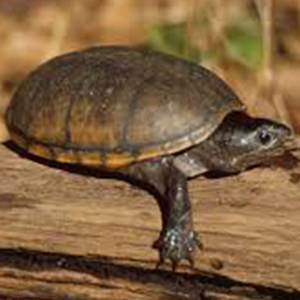
|
Class:
|
Reptilia
|
|
Order:
|
Testudines
|
|
Family:
|
Kinosternidae
|
|
Genus:
|
Sternotherus
|
|
Species:
|
odoratum
|
|
Life span:
|
50 or more years
|
|
Egg Gestation:
|
Females lay 1 – 9 eggs that hatch 60 – 85 days later
|
|
Number of young at birth:
|
1 – 9
|
|
Age of maturity:
|
3 – 4 years
|
|
Size:
|
Shell averages 3 – 5 in. long
|
|
Weight:
|
1 – 2 lb
|
|
Size at birth:
|
Less than 1 in.
|
|
Description:
|
Olive brown to dark gray turtle with a highly domed, oval shaped carapace. The carapace is often covered with a camouflaging layer of algae. Have two bright facial stripes beneath their eyes and small, tentacle-like sensory extensions known as barbels on their chins and throats. The lower shell is small and has a single hinge which enables the turtle to partially close and protect itself.
|
| Diet: | Eats earthworms, snails, clams, crayfish, crabs, insects, tadpoles, fish and fish eggs. Also eats some plant foods like algae. |
| Range: | Southeastern Canada, eastern and Midwestern United States and south through Texas |
| Habitat: | Lives in freshwater rivers, streams, lakes, ponds, and swamps |
Fun Facts:
-
When threatened, the common musk turtle may bite and scratch fiercely. Worse yet, it may spray its musk – an odor so vile, it has earned this turtle the nickname “stinkpot”.
-
Walks on the bottom of the stream or pond instead of swimming like other turtles.











